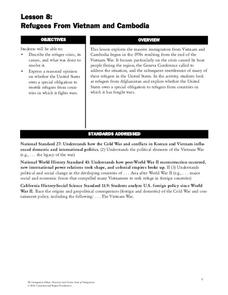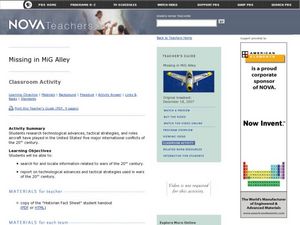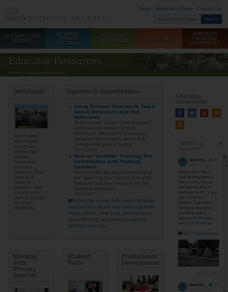Curated OER
Sources of the Cold War
Fourth graders make a time line from their notes and outlines of the causes of the Cold War.
Curated OER
Creating a Newscast on the Cold War
Learners research the events of a specific year of the Cold War. In this Cold War lesson, students investigate the causes of the Cold War and highlight the events of a particular year. Learners create a...
Curated OER
Multiple Perspectives on the Korean War
Students interpret historical evidence presented in primary and secondary resources. In this Korean War activity, students examine and analyze primary sources regarding U.S. involvement in the Korean War.
Curated OER
The Causes of Prohibition
Eleventh graders explore the origins of the Prohibition Movement in the United States. In small groups, they analyze the influence of World War I in the passage of the eighteenth amendment. Students explain how different demographics of...
Curated OER
World Religions
Ninth graders investigate the symbols and historical figures of the five main religions of the world. They participate in a class discussion, listen to a lecture and take notes, and write five Haikus, one about each major religion of...
Constitutional Rights Foundation
Refugees From Vietnam and Cambodia
The United States may have pulled its troops from the Vietnam War in 1973, but the conflict was far from over for the citizens living in Asia at the time. An informative resource lets learners know about the wave of over 220,000...
Curated OER
Literature and the "Age of Anxiety" (1920s and 1930s).
Students examine historical events of the 1920s, World War II and the Cold War. They discover how literature reflects the economic, political, social, religious and historical concerns of a culture. Students compare literature writings...
Curated OER
Focused Learning Lesson
Eleventh graders read and analyze primary source documents from World War II. They are to create a timeline of the important events by using the sources.
Curated OER
What Was the Cold War About?
Students explore a website to gather some first impressions of the Cold War era and its impact on Canadian society and politics. They, in groups, answer questions about the Cold War on a worksheet imbedded in this plan.
Curated OER
A Timeline of Cold War Events
Students create a timeline of the major events of the Cold War and explain their effect on Canada. They utilize a worksheet and a website imbedded in this plan which guide their research and presentations.
Curated OER
Debating the bomb
Students research how the development of the atomic bomb affected people in World War II. In this American History instructional activity, students participate in a debate about the bombs use. Students investigate how it has...
Curated OER
Introduction to the Holocaust
Eighth graders examine the implications of the Holocaust. In this human justice lesson, 8th graders unknowingly participate in a segregation simulation and discuss its outcome. Students compare the simulation to the discrimination that...
Curated OER
The Technological Impact on 1950's Culture
Students examine the impact of technological advancements on Cold War America. For this 1950's America lesson, students research politics, Cold War society, suburbia, and consumerism during the decade in order to better understand...
Curated OER
South Carolina Voices: Lessons from the Holocaust
Students take a closer look at life in concentration camps. In this Holocaust lesson, students listen to their instructor tell the stories of 3 Holocaust survivors and discuss the effects that victims experienced after the war
Curated OER
The Marshall Plan for Rebuilding Western Europe
Students examine the aftermath of World War II. In this Marshall Plan lesson, students listen to their instructor present a lecture regarding the plan to rebuild Western Europe and its outcome. Students respond to discussion...
Curated OER
Debating the Bomb
Students research how the development of the atomic bomb affected people in World War II, participate in a debate about the bomb's use, and investigate how it has affected people's lives since 1945.
Curated OER
Missing in MiG Alley
Students consider how technology impacted American conflicts. In this technological advances lesson, students read, "The Changing Face of War," and then describe how technology made differences in World War I, World War II, the Korean...
Curated OER
1948 - Berlin Airlift
Young scholars examine a document from the Berlin Airlift in order to research his important event in World History.
National Endowment for the Humanities
How "Grand" and "Allied" Was the Grand Alliance?
Learn more about the Grand Alliance with a scaffolded lesson plan that includes four activities. Class members use primary sources to complete a map exercise, understand the goals and objectives of each individual nation, and participate...
Constitutional Rights Foundation
History of Immigration From the 1850s to the Present
The Statue of Liberty may embrace the huddled masses of the world, but has American society always joined in? After young historians read a passage about the history of American immigration in the 19th and 20th centuries, focusing on...
Curated OER
Memorandum of a Conference with President Eisenhower after Sputnik
Students use the National Archives to research how the United States and the Soviet Union south to maintain its supremacy after World War II.
Curated OER
Immigrants Welcome?
Ninth graders examine the world after the end of World War II. In groups, they complete a Naturalization Review Board activity and discuss how immigrants changed the United States. As a class, they discover how the immigration policies...
Curated OER
The Living Weapon
Students explore American history, military strategy and scientific discovery near the end of the World War II era. They examine the principles of the Cold War, pacifism, and the desire to keep government programs secret from the...
Curated OER
Daniel's Story Study Guide
Students explore the plight of Jews during the Holocaust. In this World War II lesson, students read Daniel's Story by Carol Matas and complete the provided comprehension, characterization, and vocabulary activities.























